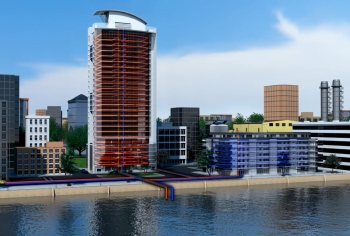Energy in the loop

Why deliver heating and cooling as separate services when a single heat-pump system can do both — asks Richard Venga of Mitsubishi Electric.
The UK now has some of the toughest, legally binding targets for carbon reduction, and this is having a major effect on the way we use energy in our buildings. The Climate Change Act of 2008, the Carbon Reduction Commitment and the Energy Performance of Buildings Directive are all demanding that we find more energy efficient ways to heat and cool the buildings we work, rest and play in.
And yet there is now a proven technology that can enable almost any commercial building to use energy in a more efficient way — heat pumps, whether in the form of renewable heating, or in a heat-recovery VRF air conditioning system.
A standalone air-to water-heat pump will harvest renewable energy from the outdoor air to deliver renewable heating whilst also allowing the owner to qualify for Government incentives in the form of the commercial renewable heat incentive (RHI).
A VRF heat-recovery air-conditioning system will take heat from one area needing cooling (such as a server room, or hotel bedrooms) and use it in areas needing heating (offices and meeting areas). These systems can also link with other equipment such as air curtains to increase efficiency further.
To fully understand the value of what heat pumps can offer, we need to remember that the by-product of heating is cooling — and vice versa. If we can capture this by-product we can use it in other parts of the building as a kind of energy loop.
Because we can readily connect heat pumps to this energy loop, we can use them to transfer low-grade heat from one part of the building — or even one part of the community —and use the heat pump to upgrade this heat to deliver the necessary heating or cooling for that individual building, office or room.
This makes heat pumps ideal for almost any building, and they are particularly suitable for high-rise premises.
Taller buildings with an LPHW heating system typically contain a high-temperature riser which although heavily insulated still leaks heat into the corridors and lift shaft. Those heat losses often cause overheating in summer — a common problem for many building-services engineers. The building may also contain a boiler flue, which is also high temperature and has a large diameter.
To achieve cooling in the building, a chilled-water riser or condenser loop is used to carry low-temperature water up and down the building. Any rejected heat is often released into the atmosphere and wasted.
If we focus instead on using a single energy loop in taller buildings, we can dramatically save on the space required for services by removing the need for a high-temperature riser, removing the need for a boiler flue and using a re-engineered condenser loop to meet all of the heating, cooling and hot water requirements using heat-pump technology.
Individual circuits can join individual heat-pump units to this energy loop to add or extract heat from it, giving us a more balanced use of energy throughout the building, yet still meeting the individual requirements of a floor, a room, or an apartment.
The concept of harvesting low-grade energy has been recognised by the Government, which has mapped out the untapped resource running through the heart of our communities in the form of rivers and open water such as lakes and estuaries.
In August 2014, The Department of Energy & Climate Change introduced a water-source heat map of England to help illustrate the opportunities available for deploying-heat pump technology in the country’s river and open water sources.

The water-source heat map therefore demonstrates the enormous potential available.
The technology is also now supported by the new code of practice for surface water heat pumps practice; it offers practical guidance and a set of minimum standards for this type of application, from inception to commissioning.
In the case of an open-water energy loop, low-grade heat is harvested from the river or lake and upgraded using heat-pump technology to deliver hot water and heating to a building. This upgraded heat can then be further enhanced at an apartment or office level to deliver full control and individual billing.
Most importantly energy for heating, cooling and hot water is moved around a building or district at ambient temperatures, vastly reducing losses and cost.
This is already being used in London, where heating is being delivered to over a hundred apartments built 200 m from the River Thames. When the hotel alongside the development starts to operate, we will be able to see the full effect of a highly efficient energy loop as the heat recovered from cooling hotel bedrooms is used to deliver hot water to the homes next door.
In addition, by linking different types of buildings and energy use, the energy loop is capable of achieving a natural balance — significantly reducing carbon emissions through heat recovery.
Once we fully grasp the concept of the energy loop, it is clear to see that it is just as effective to use energy from rivers or lakes as it is from high-temperature district-heating systems, CHP, or gas boilers — yet still deliver full autonomy and control within individual systems and buildings.
We can also add to this energy loop from many different external sources, whether that is a community heating scheme, waste heat from industrial processes or from natural sources of energy such as open water, as highlighted in the 2013 policy document from the DECC ‘The future of heating: meeting the challenge’.
So, whether we recover heat from industrial processes or cooling server rooms and hotels, or harvest low-grade energy from open water sources, we can utilise this energy and reuse it to reduce overall consumption and carbon emissions.
And it’s all possible thanks to what is now the proven technology of the humble heat pump.
Richard Venga is specification engineer with Mitsubishi Electric.








